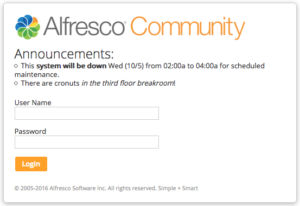 I’ve seen a few questions about how to configure an Alfresco project to depend on other add-ons when using the Alfresco Maven SDK, so I thought I’d do a quick write-up on that.
I’ve seen a few questions about how to configure an Alfresco project to depend on other add-ons when using the Alfresco Maven SDK, so I thought I’d do a quick write-up on that.
When you use the Alfresco Maven SDK Archetypes to bootstrap a project, you can select one of three project types:
- alfresco-allinone-archetype: Referred to simply as “All-in-One”, this type, as the name implies, gives you a project that facilitates creating both a repository tier AMP and a Share tier AMP, plus it includes a working Solr installation.
- alfresco-amp-archetype: This sets up a project that generates only a repository tier AMP.
- share-amp-archetype: This sets up a project that generates only a Share tier AMP.
In my Alfresco Maven SDK Tutorial I use both the alfresco-amp-archetype and the share-amp-archetype but I don’t really talk about the All-in-One archetype at all. The reason is two-fold. First, I think for most beginners, the smaller, more focused archetypes are less confusing. Second, on the vast majority of my client projects, that’s the setup I use. Usually, I feel like the All-in-One archetype is overkill.
However, there is an advantage the All-in-One archetype has over the other two. It is able to pull in other AMPs as dependencies. With the single-purpose archetypes, your goal is simply to build an AMP. You can run integration tests against that AMP using the embedded Tomcat server, but if you want to test the AMP with other AMPs, you have to deal with that manually. Usually I just deploy the AMPs to a test Alfresco installation that already has the other AMPs deployed.
But with the All-in-One archetype, you can declare those other AMPs as dependencies, and Maven will go grab them from a repository and install them into your local test environment using something called an “overlay”.
Here’s an example. Suppose you are developing some customizations that you know will be deployed to an Alfresco server that will be running the following add-ons: Share Site Creators, Share Site Space Templates, Share Login Announcements, and Share Inbound Calendar Invites. You’d like to test your code alongside these add-ons.
One approach would be to go grab the source for each of these projects and build them locally to produce their AMPs (or download pre-built AMPs), then deploy all of those AMPs to a test server, then deploy your custom AMP and test.
But all of those add-ons happen to live on a public Maven artifact repository called Maven Central. So a better alternative might be to simply list those modules as dependencies and let Maven take care of the rest.
Here’s how it works. When you generate an all-in-one project, the structure includes not only folders that contain your repo and Share AMP source, but also folders representing the Alfresco and Share web applications. For example, here are the files and folders in the root folder of a project called “test-allinone-220”:
pom.xml repo run.bat run.sh runner share solr-config test-allinone-220-repo-amp test-allinone-220-share-amp
In our example, your custom code for the repo tier would go in test-allinone-220-repo-amp and your Share tier code would go in test-allinone-220-share-amp.
The repo and share directories are used to build the respective WAR files and they each have their own pom.xml. So to add the other add-ons to our setup, first edit repo/pom.xml. You need to add the add-ons as dependencies, like:
<dependency>
<groupId>com.metaversant</groupId>
<artifactId>inbound-invites-repo</artifactId>
<version>1.1.0</version>
<type>amp</type>
</dependency>
<dependency>
<groupId>com.metaversant</groupId>
<artifactId>share-site-space-templates-repo</artifactId>
<version>1.1.2</version>
<type>amp</type>
</dependency>
<dependency>
<groupId>com.metaversant</groupId>
<artifactId>share-login-ann-repo</artifactId>
<version>0.0.2</version>
<type>amp</type>
</dependency>
<dependency>
<groupId>com.metaversant</groupId>
<artifactId>share-site-creators-repo</artifactId>
<version>0.0.5</version>
<type>amp</type>
</dependency>
Then, add them again to the overlays section (without the “version” element), like this:
<overlay>
<groupId>com.metaversant</groupId>
<artifactId>inbound-invites-repo</artifactId>
<type>amp</type>
</overlay>
<overlay>
<groupId>com.metaversant</groupId>
<artifactId>share-site-space-templates-repo</artifactId>
<type>amp</type>
</overlay>
<overlay>
<groupId>com.metaversant</groupId>
<artifactId>share-login-ann-repo</artifactId>
<type>amp</type>
</overlay>
<overlay>
<groupId>com.metaversant</groupId>
<artifactId>share-site-creators-repo</artifactId>
<type>amp</type>
</overlay>
That covers the Alfresco WAR. Now for the Share WAR, edit share/pom.xml and add the Share tier dependencies, like:
<dependency> <groupId>com.metaversant</groupId> <artifactId>share-login-ann-share</artifactId> <version>0.0.2</version> <type>amp</type> </dependency> <dependency> <groupId>com.metaversant</groupId> <artifactId>share-site-creators-share</artifactId> <version>0.0.5</version> <type>amp</type> </dependency>
And then the overlays:
<overlay> <groupId>com.metaversant</groupId> <artifactId>share-login-ann-share</artifactId> <type>amp</type> </overlay> <overlay> <groupId>com.metaversant</groupId> <artifactId>share-site-creators-share</artifactId> <type>amp</type> </overlay>
Now you can run the whole thing–your custom AMPs plus all of the dependencies–by running ./run.sh. As part of the build, you should see the dependencies being downloaded from Maven Central. As the server starts up, if you watch the log, you’ll see the modules get initialized. And when you log in, you’ll be able to test all of the functionality together.
When you are ready to deploy to one of your actual server environments, you have a choice. You can either copy all of your AMPs to the amps and amps_share directories, then run bin/apply_amps.sh. Or you can deploy the WAR files that are now sitting under repo/target and share/target. Personally, I think re-applying the AMPs against a fresh WAR on the target server is less confusing and less error-prone, but I’ve seen it done both ways.
If the add-ons you want to depend on are not on a public Maven artifact repository like Maven Central, you can still build them locally, run “mvn install” to install them into your local Maven repository, then depend on them as shown.





